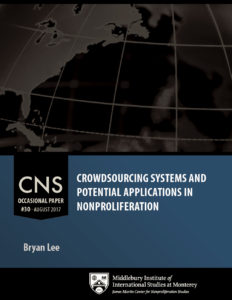August 10, 2017
Bryan Lee
Occasional Paper #30
Read the full Occasional Paper #30:
Crowdsourcing Systems and Potential Applications in Nonproliferation
Executive Summary

This report provides an overview of crowdsourcing systems and identifies the key elements in their successful operation. It also offers an examination of best practices for US government implementation of crowdsourcing projects. Finally, it describes four instances of crowdsourcing projects with applicability to arms control and nonproliferation.
Crowdsourcing systems have been used to address a variety of problems, but government applications are typically restricted to one of four types:
- Knowledge discovery and management
- Distributed human intelligence tasking
- Broadcast search
- Peer-vetted creative production
Successful crowdsourcing outcomes are the result of both proper problem identification and an appropriately structured crowdsourcing management system. This study identifies the key management tasks as user management, task management, contribution management, and workflow management. In addition, two design tasks were identified, incentive design and crowd curation.
Using publicly available information, the report examines four case studies where public and private sector actors implemented crowdsourcing systems. The cases cover various proliferation-relevant topics, such as border management, scientific problem solving, arms trafficking, and crime reporting and tracking. In each case, success or failure was largely attributed to the degree of management involvement and the implementation of the key management and design tasks mentioned above.
The growing body of government-sponsored crowdsourcing projects as well as the establishment of a government crowdsourcing center of excellence should give additional insights into the development and application of crowdsourcing systems. Until the results are widely shared and adopted, however, an examination of the key tasks provided here together with a review of the selected case studies can provide a shortcut for implementation. With the appropriate degree of management focus, there is every reason to believe nonproliferation and arms-control efforts can also benefit from crowdsourcing methods and technologies.
